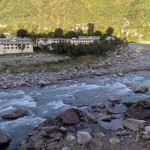Governance of transboundary rivers in South Asia is both complex and challenging due to a peculiar mix of imperatives relating to geography, demographics, and geopolitics. Hosting a quarter of the world’s population, the region, however, has no choice but to improve its record of riparian governance if it is to contribute more to the world’s well-being and its own.
The record of regional cooperation on rivers since India’s independence in 1947 is one of several successes, but also much contestation.
The Indus Waters Treaty (1960), involving six rivers shared by India and Pakistan, has perhaps been the biggest success. It was crafted during Prime Minister Jawaharlal Nehru’s time, with the initiative of the World Bank, valuable technical advice from the U.S. and generous international financial assistance. The treaty survived three wars between the two countries and decades of Pakistan-supported terrorism against India. Its mechanism for cooperation, the Permanent Indus Commission, has performed well.
The Ganges Water Sharing Treaty (1996) between India and Bangladesh resolved one of the most contentious issues affecting bilateral relations between the two countries. It showed the possibilities of diplomacy, with reason prevailing over emotion. Prime Minister Sheikh Hasina described this relationship in 2017 as ‘a flowing river and full with generosity.’ Another praiseworthy model of water cooperation exists between India and Bhutan, producing ample hydropower and bringing benefits to both countries.
Yet, differences and disputes continue on facets of water-related governance between India and Pakistan, India and Nepal, and even India and Bangladesh. India figures in all these equations, not because of its size or policy, but because it is a middle riparian country. It often faces challenges from two directions: China – the source of several major rivers – and the lower riparian countries such as Pakistan and Bangladesh. With the latter, the key issue in recent years has been the unresolved sharing of waters of the Teesta River in the dry season. In 2011, the two governments were on the verge of reaching an agreement when the state government of West Bengal refused to come on board. Since then, political configurations at national and state levels are yet to align enough to clear the agreement.
India and China also have a mixed record on riparian cooperation. China, as the upper riparian country controlling the Brahmaputra, (known there as Yarlung Tsangpo), is perceived to be damming it and diverting the waters in southern Tibet. Moreover, it often fails to share data on water flows with Indian authorities, thereby hampering India’s measures to protect land and habitation from devastation caused by floods and siltation. Credibility of data is also an issue.
The two countries need to hold a serious conversation on forging long-term riparian cooperation. But now, in October 2020, chances appear dim in light of China’s aggressiveness in eastern Ladakh and elsewhere.
India is committed to moving forward – and fast – on the path of economic development which is human-centric, equitable and sustainable, despite the disruptions caused by the COVID-19 pandemic. The national water policy and the National Waterways Act 2016 lay emphasis on the all-round utilization of rivers for development, ranging from irrigation and agriculture to inland transportation, trade and tourism. The use of modern technology, green energy, and environmentally sound practices is encouraged.
In the Northeast region of the country comprising eight states that border five neighbouring countries (Nepal, Bhutan, China, Bangladesh and Myanmar), there is growing consensus among policymakers and scholars that the entire development spectrum from ecology to economy should be driven by data, science and common sense.
An interesting recent feature in India is that public debate has been robustly joined by the civil society or the ‘Third Space’. Media, universities and think tanks (such as the Shillong-based Asian Confluence) have been making a stellar contribution towards defining challenges and suggesting solutions. They advocate holistic development of people, their livelihoods and cultures, using rivers as connecters rather than dividers.
Effective transboundary river management demands regional cooperation among countries that share rivers. Having factored in Pakistan’s patently negative attitude towards SAARC, India has shifted gears, investing much political and diplomatic capital in a small but promising grouping – BIMSTEC. Working quietly since its successful summit in 2018, this grouping now stands on the verge of major rejuvenation. Its new charter is ready and so are other initiatives which will be unveiled at the next summit, to be hosted by Colombo in January 2021.
BIMSTEC is perhaps the only regional body committed to promoting the Mountain Economy and the Blue Economy, anchored on the belief that mountains, rivers and oceans form nature’s unbreakable cycle. India’s push for cooperation in relevant sectors – fisheries and aquaculture, coastal shipping, port connectivity and offshore energy farms, among others – should be welcomed and supported.
Another grouping named the Mekong Ganga Cooperation (MGC) has been strengthening cooperation in education, culture, tourism, transport and communications among its six members: India, Thailand, Myanmar, Vietnam, Laos and Cambodia. The creative idea of linking lands washed by Asia’s two powerful rivers, the Ganga and the Mekong, deserves to be backed.
In the past, governments strove to divide and share river waters. Now they are thinking about comprehensive river basin development. Thus, the task has become even more complex. Another noteworthy trend in water governance and regional cooperation is India’s marked eastward tilt. This stems from the increasing centrality of the country’s Northeast and its immediate external neighborhood, especially Bangladesh and Myanmar. Together they stand at the intersection of India’s ‘Neighbourhood First’ and ‘Act East’ policies. The medium-term objective aims to establish the ‘Bay of Bengal Community’.
Developments culminating in 2020 reflect New Delhi’s conviction that the Indo-Pacific is set to be the most consequential theatre of global geopolitics in the coming decades. India’s policy on transboundary river governance may be shaped accordingly.
Rajiv Bhatia is Distinguished Fellow, Gateway House, and a former Ambassador to Myanmar.
This article was originally published by Asia Pacific Bulletin, East-West Center, Washington, DC.


